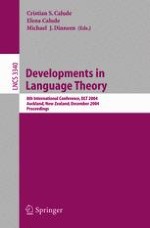2005 | Buch
Developments in Language Theory
8th International Conference, DLT 2004, Auckland, New Zealand, December 13-17, 2004. Proceedings
herausgegeben von: Cristian S. Calude, Elena Calude, Michael J. Dinneen
Verlag: Springer Berlin Heidelberg
Buchreihe : Lecture Notes in Computer Science
